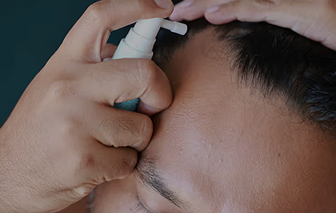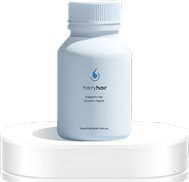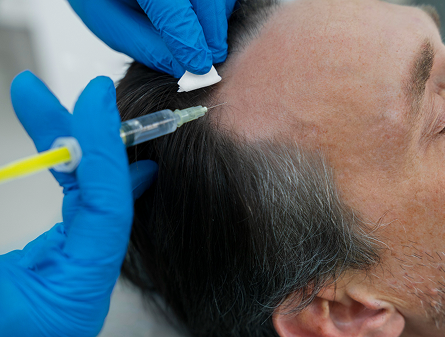Finasteride is a hair regrowth medication used in the treatment of male pattern hair loss. It is a dihydrotestosterone (DHT) blocker, which means it prevents the hair follicles from shrinking and becoming weaker eventually causing hair loss. Hair vitamins can help prevent hair shedding.
They are most effective if you have a nutrient deficiency that is causing your hair loss. Finasteride is designed to be a long-term treatment that needs to be taken consistently to see and maintain results.
Hair vitamins can be helpful in treating a range of conditions according to studies including alopecia areata, alopecia totalia, alopecia universalis, and androgenic alopecia (also known as pattern baldness). Check out the comparison table below to see the differences between finasteride and hair vitamins.
- Finasteride is a DHT-blocking oral medication used to prevent hair thinning in men.
- Unlike hair vitamins, it treats the hormonal root cause of pattern hair loss.
- Hair vitamins support hair growth by addressing nutritional deficiencies.
- Compared to Finasteride, they are non-hormonal and suitable for both men and women.
- Finasteride typically costs $30–$70 per month with a prescription.
- More costly than hair vitamins over time, but targets hair loss more aggressively.
- Hair vitamins cost around $10–$30 monthly and are available over the counter.
- Unlike finasteride, they are budget-friendly and do not require a prescription.
- Finasteride is taken daily and usually shows results in 3–6 months.
- Continued use of finasteride is needed to maintain benefits.
- Hair vitamins are also taken daily, with results typically appearing after 2–4 months.
- Compared to finasteride, results may be less dramatic and slower to appear.
- Finasteride is taken orally and works systemically to reduce DHT.
- Targets the hormonal cause of hair loss.
- Hair vitamins are oral supplements that supply nutrients to support healthy hair.
- Unlike finasteride, they nourish from within without hormone interaction.
- Finasteride may be connected with sexual dysfunction or mood change as side effects.
- Requires medical supervision, especially for long-term use.
- Hair vitamins are well tolerated and usually safe if not overconsumed.
- In comparison with finasteride, they carry a lower risk.
- Finasteride is easy to use, requiring just one tablet daily.
- No special instructions or preparation needed.
- Hair vitamins are similarly easy to take as a daily supplement.
- Unlike finasteride, there’s no concern about renewing a prescription.
- Finasteride is available only via prescription in Australia.
- Access requires a doctor’s consultation and ongoing monitoring.
- Hair vitamins are sold over the counter at pharmacies and supermarkets.
- More accessible than finasteride and suitable for a broader range of users.
- Finasteride maintains results while in use, but stopping treatment can lead to hair loss again.
- Consistent use is required for ongoing benefits.
- Hair vitamins support scalp and hair health, but results fade if discontinued.
- Compared to finasteride, results are more dependent on nutritional balance.
- Finasteride is often used alongside minoxidil and other topical treatments.
- It can be used in conjunction with vitamins for internal support.
- Hair vitamins are compatible with medications like finasteride or minoxidil.
- Unlike finasteride, they serve a complementary rather than primary role in hair loss treatment.
- Finasteride appeals to users seeking a clinically proven, targeted solution.
- Often chosen for its strong DHT-blocking potential if you have a history of pattern baldness.
- Hair vitamins appeal to those preferring natural, wellness-oriented approaches.
- Compared to finasteride, they work more holistically.
- Finasteride supports hair retention and may help with benign prostate conditions.
- Does not directly improve skin or overall wellness.
- Hair vitamins often support nails, skin, energy levels, and hair health.
- Unlike finasteride, the benefits extend beyond hair-related improvements.
- Finasteride generates waste from monthly packaging and pharmacy handling.
- Ongoing prescriptions contribute to its footprint.
- Hair vitamins also create waste from recurring bottles and packaging.
- Compared to finasteride, the impact is similar unless purchased in bulk.
Shop our hair solutions
We are committed to providing affordable hair regeneration services for people all over Australia. Our formula can help you regain your confidence.
Shop Now

Finasteride vs Vitamins For Hair Loss Prevention Comparison Summary
Finasteride has been shown to be a highly effective treatment for pattern hair loss according to studies. DHT levels can be lowered by up to 72 per cent allowing hair to grow healthy and strong. The effectiveness of hair vitamins can depend on the quality of the ingredients and the formulation of the supplement.
Results were observed in studies after 6-month and 12-month periods. Finasteride results can be observed after 3 months but the effectiveness of finasteride only continues to improve over time according to studies. The cost of finasteride can depend on where you live and how you access the medication.
It can be acquired online through a subscription service where it may be combined with other hair growth ingredients that can tackle different causes of hair loss. Hair vitamins come at a comparable price but they may not be as effective a treatment option compared to finasteride. Subscription services are also available for hair vitamins which can offset the cost in the long run.
User Guidance
Finasteride is typically well tolerated with less than 2 per cent of users experiencing side effects according to studies. Potential side effects are systemic and can include issues with sexual function such as loss of libido, erectile dysfunction, and ejaculation problems.
Hair vitamins are considered to be safe to take but you should consult with a healthcare professional before starting them. This is because if you over-consume certain vitamins like vitamin A or vitamin E it may cause your hair to fall out or lead to more serious health issues. Finasteride is quite widely available but does typically require a prescription.
This can now be acquired online through subscription services, however. Hair vitamins are easily accessible and can be acquired over the counter. If you have a serious nutrient deficiency that is causing your hair loss, you may need to have a stronger supplement prescribed to you by your GP.
Take Our Hair Loss Quiz to See Which Treatment Suits You?
Take A Hair Quiz

Frequently Asked Questions
We have put some commonly asked questions.
Nunc scelerisque tincidunt elit. Vestibulum non mi ipsum. Cras pretium suscipit tellus sit amet aliquet. Vestibulum maximus lacinia massa nontor.
Platelet-rich plasma (PRP) treatment involves drawing blood from the patient, isolating the beneficial nutrients and injecting it into the scalp where hair loss is occurring. This promotes hair growth and has many other applications from encouraging healing to skin rejuvenation.
Platelet-rich plasma (PRP) treatment involves drawing blood from the patient, isolating the beneficial nutrients and injecting it into the scalp where hair loss is occurring. This promotes hair growth and has many other applications from encouraging healing to skin rejuvenation.
Platelet-rich plasma (PRP) treatment involves drawing blood from the patient, isolating the beneficial nutrients and injecting it into the scalp where hair loss is occurring. This promotes hair growth and has many other applications from encouraging healing to skin rejuvenation.







 See All
See All